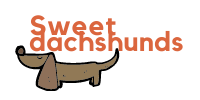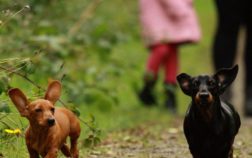Are you struggling to manage your dachshund’s aggressive behavior? Look no further! In this article, we will explore some highly effective methods to help you put an end to dachshund aggression. Whether it’s excessive barking, growling, or even biting, we’ve got you covered with practical strategies that will restore peace and harmony in your home. Say goodbye to the stress and frustration caused by your dachshund’s aggressive tendencies, and say hello to a healthier and happier relationship with your beloved four-legged friend!
Understanding Dachshund Aggression
Dachshunds are generally known for their friendly and lively nature, but like any breed, they can sometimes display signs of aggression. It is important for dog owners to understand the common causes and types of aggression in dachshunds, as well as recognize the early signs. By understanding the root causes of aggression, we can take the necessary steps to prevent and manage this behavior effectively.
Common causes of aggression in dachshunds
Aggression in dachshunds can stem from various factors, including fear, possessiveness, territoriality, or lack of socialization. Fear-based aggression is often triggered by situations or stimuli that the dog perceives as threatening. Possessiveness aggression occurs when a dachshund becomes overly protective of their food, toys, or personal space. Territorial aggression is seen when a dachshund becomes defensive towards their home or yard. Lastly, inadequate socialization during puppyhood can lead to aggression towards other animals or strangers.
Different types of dachshund aggression
Dachshunds can exhibit aggression in different ways, depending on the underlying cause. Some common types of aggression in dachshunds include dominance aggression, fear aggression, territorial aggression, and redirected aggression. Dominance aggression occurs when the dog tries to establish their authority or control over others. Fear aggression is displayed when a dachshund feels threatened or anxious. Territorial aggression is seen when a dachshund becomes defensive of their space. Redirected aggression happens when a dachshund redirects their aggression towards something or someone else due to frustration or excitement.

Recognizing early signs of aggression in dachshunds
Early detection of aggression is crucial for effective management. Some signs of aggression in dachshunds include growling, baring teeth, snapping, biting, raised fur or hackles, lunging, or intense staring. It is important to pay attention to body language such as stiff posture, raised tail, ears pinned back, or dilated pupils. If you notice any of these signs, it is essential to address the issue promptly and take appropriate measures to prevent the aggressive behavior from escalating.
Preventing Dachshund Aggression through Socialization
Proper socialization plays a vital role in preventing aggression in dachshunds. By exposing them to various people, animals, and environments from an early age, we can help them develop confidence and positive associations with new experiences.
Importance of early socialization
Early socialization is critical during the first few months of a dachshund’s life. This period is when they are most receptive to new experiences and can learn to adapt and feel comfortable in different situations. Introducing them to a wide range of people, including children, adults, and individuals of various ethnicities, can help dachshunds become more accepting and tolerant of different personalities.
Introducing dachshunds to new people and animals
Gradually exposing dachshunds to new people and animals can help them build positive associations. Start with controlled interactions in a neutral environment, such as a park or a friend’s backyard. Allow the dachshund to approach at their own pace and provide treats and praise for calm and friendly behavior. Supervise interactions closely, and if there are any signs of aggression, calmly redirect their attention and remove them from the situation if necessary.

Positive reinforcement during socialization
During socialization, it is essential to use positive reinforcement techniques to reinforce good behavior. Rewarding dachshunds for calm and friendly interactions with treats, praise, and affection will help them associate positive experiences with meeting new people and animals. This positive reinforcement will encourage them to continue displaying friendly behavior and reduce the likelihood of aggression.
Effective Training Techniques to Reduce Aggression
Proper training is crucial for managing and reducing aggression in dachshunds. By using positive reinforcement methods and teaching obedience commands, we can establish boundaries and reinforce desirable behavior.
Using positive reinforcement training methods
Positive reinforcement training methods involve rewarding desirable behavior rather than punishing unwanted behavior. When a dachshund displays calm and non-aggressive behavior, provide treats, praise, and affection to reinforce that behavior. This approach helps the dog associate good behavior with positive outcomes, making it more likely to be repeated in the future.
Properly teaching and enforcing obedience commands
Teaching dachshunds basic obedience commands like “sit,” “stay,” and “leave it” can help establish control and prevent potentially aggressive situations. Obedience commands allow you to redirect your dachshund’s attention and focus, giving you the opportunity to reward them for calm behavior. Consistently practicing these commands in various environments will reinforce their training and help prevent aggressive outbursts.
Consistency and patience in training dachshunds
Consistency is key when training dachshunds to reduce aggression. Establish clear rules and expectations, and ensure that all family members or caregivers follow them consistently. This consistency helps dachshunds understand what is expected of them and reduces confusion or frustration that can lead to aggression. It is crucial to remain patient throughout the training process, as changing behavior takes time. Celebrate small successes and progress, and remember that persistence and positive reinforcement will yield the best results.
Seeking Professional Help for Aggressive Dachshunds
If your dachshund’s aggression persists or escalates despite your efforts to manage it, seeking professional help from a dog trainer or behaviorist is recommended. These professionals have the knowledge and experience to assess your dachshund’s behavior and provide targeted interventions.
When to consult a professional dog trainer or behaviorist
Consulting a professional should be considered when a dachshund’s aggression poses a risk to others or significantly affects their quality of life. If you feel overwhelmed, unable to manage the aggression effectively, or if the behavior worsens over time, it is essential to seek professional guidance. A qualified dog trainer or certified animal behaviorist can assess the situation, identify the root causes of aggression, and develop a customized training and behavior modification plan.
Choosing the right professional for dachshund aggression
When selecting a professional for dachshund aggression, it is important to choose someone who has specific experience and expertise in dealing with aggressive behaviors. Look for professionals with positive reviews, certifications, and a solid track record of successfully addressing aggression in dogs. It is also beneficial to find a professional who uses force-free, reward-based training methods to ensure the well-being and emotional health of your dachshund.
Types of intervention used by professionals
Professionals may use various techniques to address dachshund aggression, depending on the underlying causes and severity of the behavior. Behavior modification techniques such as desensitization and counterconditioning can help change your dachshund’s emotional response to triggers. They may also guide you in implementing management strategies, environmental modifications, and training exercises to redirect and manage aggressive behavior. Collaborating with a professional can give you the support and guidance needed to effectively address your dachshund’s aggression.
Creating a Safe Environment for Aggressive Dachshunds
In addition to training and behavior modification, creating a safe environment plays a crucial role in managing aggression in dachshunds. By identifying triggers, providing a designated safe space, and using management tools, we can minimize potential aggressive incidents.
Identifying triggers and avoiding them
Understanding what triggers your dachshund’s aggression is essential to prevent aggressive episodes. Keep a record or journal of incidents to identify common patterns or situations that lead to aggression. Once triggers are identified, take steps to avoid or manage them. For example, if your dachshund becomes aggressive during mealtime, feeding them in a separate space or using food-dispensing toys can reduce competition and tension.
Providing a designated safe space for dachshunds
Creating a designated safe space for your dachshund can provide them with a retreat when they feel overwhelmed or anxious. This safe space should be quiet, comfortable, and free from potential triggers. It can be a specific room, a crate, or a gated area where your dachshund can go to relax and decompress. Providing access to their safe space when needed allows them to self-regulate their emotions and reduces the likelihood of aggressive behavior.
Using baby gates or crates to manage aggression
Baby gates and crates can be useful tools in managing aggressive behavior in dachshunds. Placing baby gates strategically in your home can separate your dachshund from triggers or situations that may provoke aggression. Crates can serve as safe and secure areas for your dachshund during times when supervision or confinement is necessary. Properly introducing your dachshund to a crate and ensuring it is a positive and comfortable space can help manage their aggression and reduce potential risks.
Managing Dachshund Aggression with Exercise and Mental Stimulation
Physical exercise and mental stimulation are essential aspects of managing aggression in dachshunds. By providing outlets for their energy and providing challenging activities, we can reduce their frustration and redirect their focus.
Importance of physical exercise for dachshunds
Regular physical exercise is crucial for dachshunds to release pent-up energy and prevent boredom. Engaging in activities such as daily walks, interactive play sessions, or runs in securely fenced areas can help meet their exercise needs. Exercise not only helps keep dachshunds physically fit but also contributes to their overall mental well-being, reducing stress and minimizing the potential for aggressive behavior.
Engaging in mental stimulation activities
Aside from physical exercise, mental stimulation is necessary to keep dachshunds stimulated and engaged. Interactive puzzle toys, treat-dispensing toys, and hide-and-seek games can provide mental challenges that keep dachshunds occupied and prevent boredom. Mental stimulation activities tap into their natural problem-solving abilities, divert their attention from potential triggers, and help redirect their focus in a positive way.
Using interactive toys to redirect aggressive behavior
Interactive toys can be useful tools in redirecting aggressive behavior in dachshunds. When you notice signs of aggression, providing a toy that requires engagement and problem-solving can divert their attention and redirect their focus. This technique helps shift their mindset from aggression to an activity that is mentally stimulating and rewarding. By consistently reinforcing this behavior, you can help your dachshund develop healthier responses to potentially triggering situations.
Addressing Resource Guarding in Dachshunds
Resource guarding is a common form of aggression in dachshunds and refers to the aggressive behavior displayed when they protect their valued possessions, such as food, toys, or resting places. By understanding the behavior and implementing proper training techniques, we can prevent or manage resource guarding effectively.
Understanding resource guarding behavior
Resource guarding behavior in dachshunds can range from mild displays of possessiveness to more severe aggression. Signs include growling, snapping, lunging, or biting when someone approaches their valuable resources. Recognizing these behaviors and understanding that they are driven by fear or anxiety is crucial to address the underlying causes effectively.
Preventing resource guarding through training
Training plays a fundamental role in preventing resource guarding in dachshunds. Early positive associations with people approaching their valued items are essential. Gradually desensitizing your dachshund to having their possessions approached and providing rewards for calm behavior can help them associate positive experiences with sharing their resources. Implementing a “give” or “drop it” command during play or mealtime can also teach your dachshund to willingly relinquish their possessions, reducing the likelihood of resource guarding.
Implementing controlled resource access
To manage resource guarding, implementing controlled resource access can be effective. By controlling when and how dachshunds have access to their valued items, we can prevent potential guarding behavior. For example, feeding dachshunds in separate areas or using food puzzle toys can reduce competition and eliminate the need for resource guarding. It is crucial to introduce controlled resource access gradually and consistently reinforce positive behaviors to create a balanced and harmonious environment.
Modifying Aggressive Behavior through Desensitization and Counterconditioning
Desensitization and counterconditioning are behavior modification techniques that can aid in reducing aggressive behavior in dachshunds. By gradually exposing them to triggers and pairing positive experiences, we can change their emotional response to potentially aggressive situations.
Gradual exposure to triggers
Gradual exposure to triggers is a key component of desensitization and counterconditioning. Start by exposing your dachshund to a low-intensity version of the trigger and observe their reaction. For example, if your dachshund is reactive to other dogs, start by standing at a distance where they remain calm. Over time, gradually decrease the distance while ensuring your dachshund remains relaxed and comfortable. This gradual approach allows them to build positive associations and reduces their fear or anxiety response.
Pairing positive experiences with triggers
Pairing positive experiences with triggers is essential during desensitization and counterconditioning. While exposing your dachshund to the trigger, provide them with rewards such as treats, toys, or praise. This positive reinforcement helps them associate the trigger with a positive outcome, shifting their emotional response from aggression or fear to a more positive and relaxed state. Consistency and repetition are key to effectively change their behavior and emotional reactions.
Systematic desensitization and counterconditioning techniques
Systematic desensitization and counterconditioning involve breaking down a trigger’s intensity into manageable steps. By gradually increasing the intensity or exposure to the trigger and pairing it with positive experiences, we can modify your dachshund’s emotional response. A professional trainer or behaviorist can guide you through this process, ensuring it is conducted safely and at a pace that suits your dachshund’s individual needs.
The Role of Diet and Health in Dachshund Aggression
Diet and overall health can also impact a dachshund’s aggression levels. Ensuring they receive a balanced and appropriate diet and addressing any underlying health issues is essential for their well-being and behavior.
Ensuring a balanced and appropriate diet
A balanced and appropriate diet is vital for a dachshund’s overall health and can contribute to their behavior. Feeding them a quality dog food that meets their nutritional needs can help keep them physically and emotionally balanced. Consult with your veterinarian to determine the best diet for your dachshund, considering factors like age, weight, and any specific dietary requirements. Additionally, avoiding ingredients that may trigger allergies or sensitivities can help minimize potential discomfort and irritability that can contribute to aggression.
Identifying and addressing any underlying health issues
Underlying health issues, such as pain or discomfort, can manifest as aggression in dachshunds. If your dachshund displays sudden or uncharacteristic aggression, it is important to rule out any underlying medical causes. Take your dachshund for a thorough veterinary examination, including blood work and a physical evaluation. Identifying and treating any health issues can alleviate your dachshund’s discomfort and potentially reduce aggressive behaviors.
Consulting with a veterinarian for dietary and health advice
Consulting with a veterinarian is vital when addressing aggression in dachshunds. They can provide guidance on appropriate diet, recommend any necessary dietary supplements, and help identify or address any health issues that may be contributing to the aggression. Your veterinarian can work alongside trainers or behaviorists to create a comprehensive plan that addresses both the behavioral and health aspects of your dachshund’s aggression.
The Importance of Patience and Consistency in Dealing with Dachshund Aggression
Dealing with dachshund aggression requires patience and consistent effort. Resolving aggression issues takes time, and understanding this allows for a more realistic and effective approach to managing and modifying behavior.
Understanding that aggression may take time to resolve
Aggression in dachshunds is not a quick fix and may require a significant amount of time, effort, and consistency to address effectively. Behavior modification takes time and patience to produce lasting results. It is important to manage expectations and understand that progress may be gradual. Each dog is unique, and the time it takes to resolve aggression will vary. Celebrating small victories and staying committed to the process will contribute to long-term success.
Consistently implementing training and management techniques
Consistency is crucial when working with an aggressive dachshund. Implementing training and management techniques consistently ensures that your dachshund understands and responds to your expectations. This consistency helps your dachshund establish new habits and responses, reducing the frequency and intensity of aggressive behavior. It is important to involve all family members and ensure that everyone adheres to the established rules and techniques to maintain consistency.
Rewarding progress and being patient throughout the process
Throughout the process of addressing aggression, it is essential to reward and reinforce progress. Recognize and celebrate each step forward, no matter how small. Provide praise, treats, or affection when your dachshund displays calm or non-aggressive behavior. This positive reinforcement encourages your dachshund to continue exhibiting desirable actions, reinforcing their progress. Above all, patience is key. The process of modifying aggression can be challenging, but with patience, consistency, and the right approach, significant improvements can be achieved.




